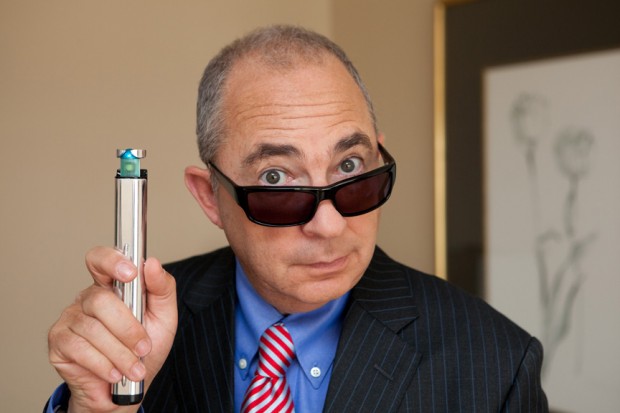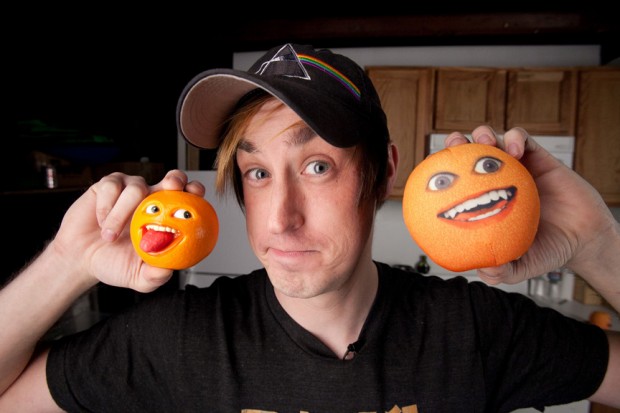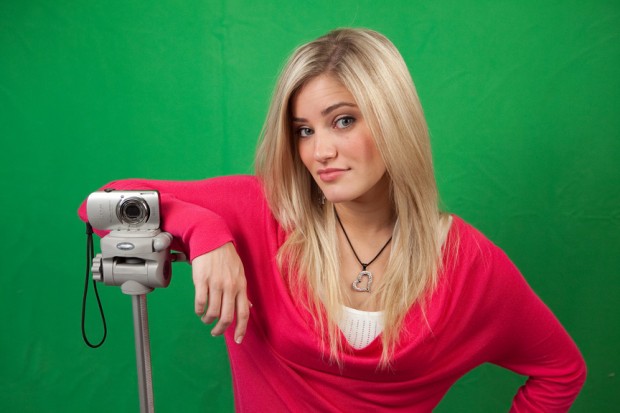
You’ve read here about the joy of using multiple flash units to produce stellar photography from the likes of Scott, Joe McNally, David Hobby and other master photographers.
I’d like to discuss here another multiple for video–as in multicam video.
Online videos have come a long way since their humble beginnings of shaky camera movement, poor sound, and minimal editing. With online videos now regularly showing up on TV sets, via Roku, Apple TV and other set-top box hookups, they’re now expected to look as polished as their offline counter-parts. Thanks to the advancements in digital technology and dramatic cost reductions, they now can.
In my new book, Video Nation, a DIY guide to planning, shooting and sharing great video, just out from Peachpit Press, I show how to dramatically improve the static old one-camera shoot. The solution: easily pair up multiple DSLRs–or even iPhones and iPads–and sync them together with Apple’s Final Cut Pro X software for TV quality like results with minimal investment and time.
I write about what I know. For the past 5 years, I have produced over 300 videos at USA TODAY for my Talking Tech and Talking Your Tech video series. All the productions are done on a low budget (this is journalism, after all) with just two of us–the host and producer, and usually Sean, who assists me with camera, lighting and sound. It’s a rare day when we don’t use at least 3 cameras for the shoot.
The standard set-up: medium, wide and close-up. It’s one camera on the guest, another on me and the third for the wide shot of both of us.
Let’s go back in time a minute to the old one-camera shoot.
Put the video camera on a tripod, place the camera operator behind it, and open with a two-shot of me and my guest. Cut. Start again, and now the camera zooms in on the guest as we continue and it stays there until the end. Cut. To close, we zoom out for a two-shot. Next we do the “reverse” shot–me nodding, and I repeat my questions to cut in later in editing.
The problem with this type of shoot: it’s visually bland, the cut-in from the interviewer usually looks fake (it is) because of the repeated questions, and the whole spontaneity of the conversation is lost.
Three cameras takes care of all this. The conversation is captured the way it really happened.
Thanks to the mammoth size of the image sensor chip in the DSLR–about 20 times larger than that found in a consumer video camera–the DSLR is usually the camera(s) of choice. The depth of field is amazing, you can shoot in low light easily, choose a variety of lenses to use and have small cameras that are easy to tote around.
GEAR:
What we bring to every shoot: Canon 5D Mark III and II and 60D cameras, Canon 70-200mm 2.8, 24-70mm 2.8, 16-35mm 2.8, 85mm 1.8 and 50mm 1.8 lenses, GoPro Hero 2 camera, the Zoom H4N audio recorder, Sony lavalier microphones, Lowell Pro and the Lowell Rifa exchange video lights and Manfrotto tripods.
The 5D shots look stellar–but the cameras are not cheap–ranging from $2,000 to $3,500.
But we also use the Canon 60D in all of the shoots as well–and that camera can be picked up now for around $800. It has the exact same imaging chip as the even less expensive Canon Rebel T3i, which is around $600, and both match really nicely with the 5D footage.
I’ve also mixed Canon DSLRs with other cameras–most notably the Samsung NX 200, Sony A77, iPhone, iPad and the GoPro Hero cameras. Sure, the footage looks different–but it also spices things up.
Let’s face it: Any good sport telecast will show an extreme array of multiple angles–you know the shot in the race car isn’t the same camera as the one used outside on the track watching it zoom by, and yet the show still goes on. The viewer is understanding.
The clips above, with actor Misha Collins (Supernatural) and talk-show host Carson Daly, were shot on the 3 Canon DSLRs–two 5Ds and a 60D. Below, with magician Penn Jillette, was mix and match–a 60D, the NX200 and a GoPro.
What if you’re on a serious budget? You can’t afford the 2 5Ds and a 60D–or even a Rebel, Nikon SLR like the D3200 or the Sony A55. You want to just use the camera that’s closest to you–like an iPhone or iPad.
It won’t look as good–but then, with proper lighting, a tripod and good microphones, it will probably turn out better than you imagined.
I did just this in a recent Video Nation promo video
with my Peachpit publisher, Nancy Aldrich-Ruenzel. I used the Apple devices to show how they can be easily used for quality video if you put your mind to it. My shot is on the iPad, while Nancy is on the iPhone4. For the wide, I added the GoPro Hero2.
—
SOUND
The video from DSLRs (and even the iPad or iPhone) looks pretty cool, but sound is always wanting. The internal microphones are as good as worthless. There are several solutions: the easiest is to pick up a cable that connects to your XLR or 1/4 inch microphone jack to plug into the DSLR or Apple device. We like the handy dandy $299 Zoom H4N audio recorder. It has two XLR inputs for microphones, a headphone input to monitor sound, and two internal microphones that are surprisingly excellent. On a recent interview, we put lav microphones on two guests, and stuck the Zoom right in front of me, for my mic, via the internal option. Sean and I were blown away–I sounded just as good as they did.
Pros and cons of working multi cam
Producing videos with one camera takes a lot less time. There’s no question about it.
But think of how many movies or TV shows you’ve watched that were shot on one camera, with one, static image. (Right–it’s not done.)
With my arsenal of gear, you can’t meet someone for a 1 p.m. interview, and expect to be set up in 5 minutes. You need to position the tripods and camera angles properly, so you’re facing each other, get the lighting right, do a sound check, etc. and this takes at least an hour to get it right.
(After the shoot, I take portraits of the subjects to go with the video. Here’s a collection of some of my favorites, all shot on the 5D Mark II or III.)

Former Sonic Solutions CEO Dave Habiger–demonstrating CD burning

Hot in Cleveland’s Valerie Bertinelli–the “muse” of coupon app Veebow

Men in Black director BARRY SONNENFELD

The Annoying Orange creator Dane Boedigheimer
EDITING
So now, the big question–how do you put it all together on the computer?
In 2011 Apple controversially remade its Final Cut Pro into a more consumer friendly editing program. For my purposes, it also produced an update in early 2012 that turned it into the DSLR shooter and editor’s best friend. Multicam clip editing.
You simply import your multiple takes, click “New Multicam clip” in the File edit menu and let FCP put them together–usually in less than 60 seconds. It uses audio cues, like Singular Software’s Plural Eyes plug-in, the go-to tool with the previous edition of FCP–the new setup with FCPX works quicker and more efficiently.
So now, during editing, you can choose the angles much like a TV director–camera 1, camera 2, camera 3, etc. and put together a more polished production
FIVE CAMERAS:
Now that we know how cool three cameras look for a shoot, Sean and I are starting to get greedy and hunger for even more. We recently dropped in to interview Matt Groening and David X. Cohen, the executive producers of the animated Futurama, and had five cameras facing the duo. To them, it must have looked like a press conference (with only one reporter!), but for us, the end result was way worth it.
Because it was a joint interview, we had one 5D on the two of them, for the two shot, a close-up each on Groening, Cohen and myself, and the fifth for the wide.
I’d like to believe that a year or two from now, we won’t be showing up for these meetings with nine or ten cameras, but who knows? One main shot on the 5D Mark III with a 70-200mm 2.8 lens, and an army of tiny GoPros picking up the rest?
The possibilities are intoxicating.
Lastly, a round of applause to Scott and Brad for the opportunity to talk about my first love–video–here today. The launch party for Video Nation is July 26th at {pages} a book store in Manhattan Beach, California, so if you’re on the west coast, please drop in and say hi. Otherwise, feel free to drop a comment or question here, or reach me at facebook.com/jeffersongraham or @jeffersongraham on Twitter.







Nice read but I have a question. How do you eliminate the camera shake when importing video from an iPhone into FCP X?
Great piece, short and to the point.
This was a really interesting read. Thanks for sharing!
Jeff Is so versatile and professional….. Thank you for sharing
Fun read, just started adding a third camera to my wedding videos and was surprised to see a post here on the blog about video for once! Thanks for the variety!
Thanks for taking the time to discuss that, I really feel strongly about it and love learning more on this topic.
http://nancytempleton.com/
Thanks forsharing, great post.
Jeff – thanks so much for sharing! I bought the book on Kindle this morning and it is just a great read. It’s filled with clear instruction with lots of encouragement for those that want to delve into video. Great post!
Thanks everyone for the nice comments–Miles Smith–you’re the first reader that I know of outside of my family, so it’s really cool to know you were able to give Video Nation a read on your Kindle. Thanks again. By the way–I’m shooting a wedding tomorrow, and will be doing 3 camera for that shoot as well. I probably should have dived into multicam for weddings too….oh well.
nice info
Here is a way to get Final cut pro for windows
http://www.youtube.com/watch?v=Yc0GOFJklx4
http://www.finalcutproforwindows.com/
An awesome easy method to get Final cut pro for windows.